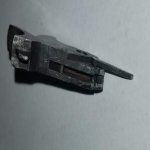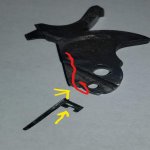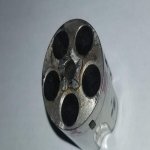Bubba here 
Just picked up a "project" 32RF Hopkins and Allen Ranger no. 2 with the comments "only moves cylinder if pointed downward, 3 out of 5 index well, the remaining 2 need help.
Upon disassembly it was clear where the first problem is: there is some kind of spring missing that is supposed to extend the indexing... sear? hand? lever? out of the frame when the hammer is being cocked. Any leads to a replacement spring or its drawings or specs? From first principles a carefully bent piece of spring steel fixed by the small pin and exerting pressure on the flat part of the hand's pin (see pic) should work - was it the supposed design or was there something more complicated such as a leaf spring there?
Also: any tips on how to correct indexing? Again from first principles, the key driving force factor be the angle between the "hand" and the indents on the cylinder (what's all of this called properly?), so if it gets stuck it engages too early and needs gentle filing to smooth out and if it fails to move it fails to engage and needs filing "into" the indent? There definitely should be a good book abut this...
P.S. Any leads on once fired 32RF brass? Want to give this baby a field test once restored.
THANKS!



Just picked up a "project" 32RF Hopkins and Allen Ranger no. 2 with the comments "only moves cylinder if pointed downward, 3 out of 5 index well, the remaining 2 need help.
Upon disassembly it was clear where the first problem is: there is some kind of spring missing that is supposed to extend the indexing... sear? hand? lever? out of the frame when the hammer is being cocked. Any leads to a replacement spring or its drawings or specs? From first principles a carefully bent piece of spring steel fixed by the small pin and exerting pressure on the flat part of the hand's pin (see pic) should work - was it the supposed design or was there something more complicated such as a leaf spring there?
Also: any tips on how to correct indexing? Again from first principles, the key driving force factor be the angle between the "hand" and the indents on the cylinder (what's all of this called properly?), so if it gets stuck it engages too early and needs gentle filing to smooth out and if it fails to move it fails to engage and needs filing "into" the indent? There definitely should be a good book abut this...
P.S. Any leads on once fired 32RF brass? Want to give this baby a field test once restored.
THANKS!













































































